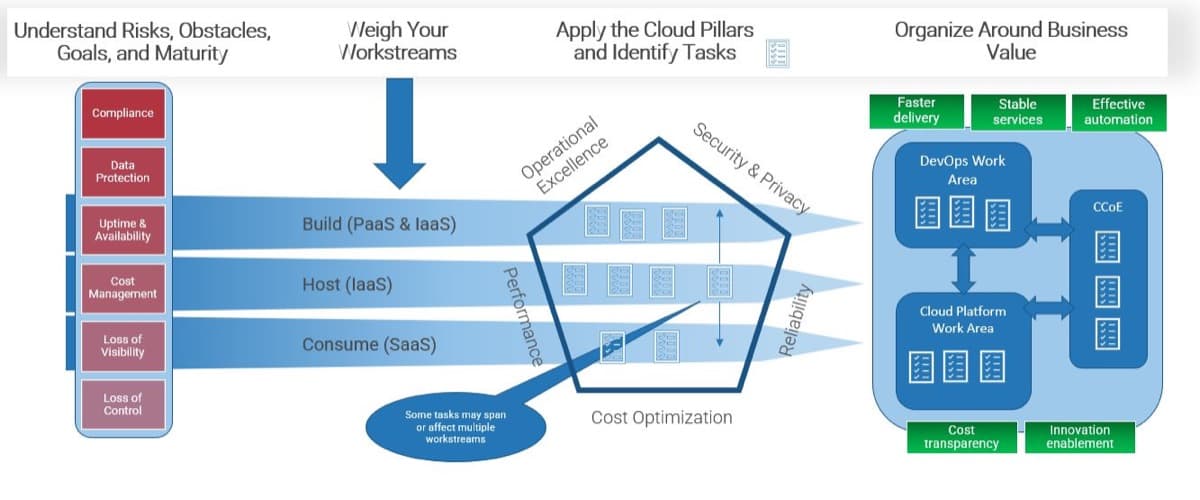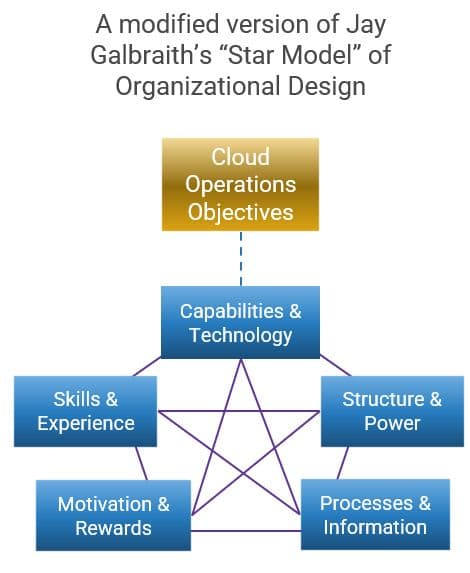Design Your Cloud Operations

- Traditional IT capabilities, activities, organizational structures, and culture need to adjust to leverage the value of cloud, optimize spend, and manage risk.
- Different stakeholders across previously separate teams rely on one another more than ever, but rules of engagement do not yet exist.
Our Advice
Critical Insight
Define your target cloud operations state first, then plan how to get there. If you begin by trying to reconstruct on-prem operations in the cloud, you will build an operations model that is the worst of both worlds.
Impact and Result
- Assess your key workflows’ maturity for life in the cloud and evaluate your readiness and need for new ways of working
- Identify the work that must be done to deliver value in cloud services
- Design your cloud operations framework and communicate it clearly and succinctly to secure buy-in
Design Your Cloud Operations Research & Tools
Besides the small introduction, subscribers and consulting clients within this management domain have access to:
1. Design Your Cloud Operations Deck – A step-by-step storyboard to help guide you through the activities and tools in this project.
This storyboard will help you assess your cloud maturity, understand relevant ways of working, and create a meaningful design of your cloud operations that helps align team members and stakeholders.
- Design Your Cloud Operations – Storyboard
- Cloud Operations Design Sketchbook
- Roadmap Tool
2. Planning and design tools.
Use these templates and tools to assess your current state, design the cloud operations organizing framework, and create a roadmap.
- Cloud Maturity Assessment
3. Communication tools.
Use these templates and tools to plan how you will communicate changes to key stakeholders and communicate the new cloud operations organizing framework in an executive presentation.
- Cloud Operations Communication Plan
- Cloud Operations Organizing Framework: Executive Brief
Infographic

Workshop: Design Your Cloud Operations
Workshops offer an easy way to accelerate your project. If you are unable to do the project yourself, and a Guided Implementation isn't enough, we offer low-cost delivery of our project workshops. We take you through every phase of your project and ensure that you have a roadmap in place to complete your project successfully.
1 Day 1
The Purpose
Establish Context
Key Benefits Achieved
Alignment on target state
Activities
1.1 Assess current cloud maturity and areas in need of improvement
1.2 Identify the drivers for organizational redesign
1.3 Review cloud objectives and obstacles
1.4 Develop organization design principles
Outputs
Cloud maturity assessment
Project drivers
Cloud challenges and objectives
Organization design principles
2 Day 2
The Purpose
Establish Context
Key Benefits Achieved
Understanding of cloud workstreams
Activities
2.1 Evaluate new ways of working
2.2 Develop a workstream target statement
2.3 Identify cloud work
Outputs
Workstream target statement
Cloud operations workflow diagrams
3 Day 3
The Purpose
Design the Organization
Key Benefits Achieved
Visualization of the cloud operations future state
Activities
3.1 Design a future-state cloud operations diagram
3.2 Create a current-state cloud operations diagram
3.3 Define success indicators
Outputs
Future-state cloud operations diagram
Current-state cloud operations diagram
Success indicators
4 Day 4
The Purpose
Communicate the Changes
Key Benefits Achieved
Alignment and buy-in from stakeholders
Activities
4.1 Create a roadmap
4.2 Create a communication plan
Outputs
Roadmap
Communication plan
Further reading
It’s “day two” in the cloud. Now what?
EXECUTIVE BRIEF
Analysts’ Perspective
 | Andrew Sharp Research Director Infrastructure & Operations Practice | It’s “day two” in the cloud. Now what? Just because you’re in the cloud doesn’t mean everyone is on the same page about how cloud operations work – or should work. You have an opportunity to implement new ways of working. But if people can’t see the bigger picture – the organizing framework of your cloud operations – it will be harder to get buy-in to realize value from your cloud services. Use Info-Tech’s methodology to build out and visualize a cloud operations organizing framework that defines cloud work and aligns it to the right areas. |
 | Nabeel Sherif Principal Research Director Infrastructure & Operations Practice | |
 | Emily Sugerman Research Analyst Infrastructure & Operations Practice | |
 | Scott Young Principal Research Director Infrastructure & Operations Practice |
Executive Summary
Your Challenge | Common Obstacles | Info-Tech’s Approach |
|---|---|---|
Widespread cloud adoption has created new opportunities and challenges:
|
| Clearly communicate the need for operations changes:
|
Info-Tech Insight
Define your target cloud operations state first, then plan how to get there. If you begin by trying to reconstruct on-prem operations in the cloud, you will build an operations model that is the worst of both worlds.
Your Challenge
Traditional IT capabilities, activities, organizational structures, and culture need to adjust to leverage the value of cloud, optimize spend, and manage risk.
- As key applications leave for the cloud, I&O teams are still expected to manage access, spend, and security but may have little or no visibility or control over the applications themselves.
- The automation and self-service capabilities of cloud aren’t delivering the speed the business expected because teams don’t work together effectively.
- Business leaders purchase their own cloud solutions because, from their point of view, IT’s processes are cumbersome and ineffective.
- Accounting practices and governance mechanisms haven’t adjusted to enable new development practices and technologies.
- Security and cost management requirements may not be accounted for by teams acquiring or developing solutions.
- All of this contributes to frustration, missed work, wasteful spending, and unacceptable risk.
Obstacles, by the numbers:
85% of respondents reported security in the cloud was a serious concern.
73% reported balancing responsibilities between a central cloud team and business units was a top concern.
The average organization spent 13% more than they’d budgeted on cloud – even when budgets were expected to increase by 29% in the next year.
32% of all cloud spend was estimated to be wasted spend.
56% of operations professionals said their primary focus is cloud services.
81% of security professionals thought it was difficult to get developers to prioritize bug fixes.
42% of security professionals felt bugs were being caught too late in the development process.
1. Flexera 2022 State of the Cloud Report. 2. GitLab DevSecOps 2021 Survey
Cloud operations are different, but IT departments struggle to change
- There’s no sense of urgency in the organization that change is needed, particularly from teams that aren’t directly involved in operations. It can be challenging to make the case that change is needed.
- Beware “analysis paralysis”! With so many options, philosophies, approaches, and methodologies, it’s easy to be overwhelmed by choice and fail to make needed changes.
- The solution to the problem requires organizational changes beyond the operations team, but you don’t have the authority to make those changes directly. Operations can influence the solution, but they likely can’t direct it.
- Behavior, culture, and organizations take time and work to change. Progress is usually evolutionary – but this can also mean it feels like it’s happening too slowly.
- It’s not just cloud, and it probably never will be. You’ll need to account for operating both on-premises and cloud technologies for the foreseeable future.
Follow Info-Tech’s Methodology
1. Ensure alignment with the risks and drivers of the business and understand your organization’s strengths and gaps for a cloud operations world.
2. Understand the balance of different types of deliveries you’re responsible for in the cloud.
3. Reduce risk by reinforcing the key operational pillars of cloud operations to your workstreams.
4. Identify “work areas,” decide which area is responsible for what tasks and how work areas should interact in order to best facilitate desired business outcomes.
Info-Tech Insight
Start by designing operations around the main workflow you have for cloud services; i.e. If you mostly build or host in cloud, build the diagram to maximize value for that workflow.
Operating Framework Elements
Proper design of roles and responsibilities for each cloud workflow category will help reduce risk by reinforcing the key operational pillars of cloud operations.
We base this on a composite of the well-architected frameworks established by the top global cloud providers today.
Workflow Categories
- Build
- Host
- Consume
Key Pillars
- Performance
- Reliability
- Cost Effectiveness
- Security
- Operational Excellence
Risks to Mitigate
- Changes to Support Model
- Changes to Security & Governance
- Changes to Skills & Roles
- Replicating Old Habits
- Misaligned Stakeholders
Cloud Operations Design
Info-Tech’s Methodology
Assess Maturity and Ways of Working | Define Cloud Work | Design Cloud Operations | Communicate and Secure Buy-in |
|---|---|---|---|
Assess your key workflows’ maturity for “life in the cloud,” related to Key Operational Pillars. Evaluate your readiness and need for new ways of working. | Identify the work that must be done to deliver value in cloud services. | Define key cloud work areas, the work they do, and how they should share information and interact. | Outline the change you recommend to a range of stakeholders. Gain buy-in for the plan. |
Blueprint deliverables
Each step of this blueprint is accompanied by supporting deliverables to help you accomplish your goals.
Assess the intensity and cloud maturity of your IT operations for each of the key cloud workstreams: Consume, Host, and Build | 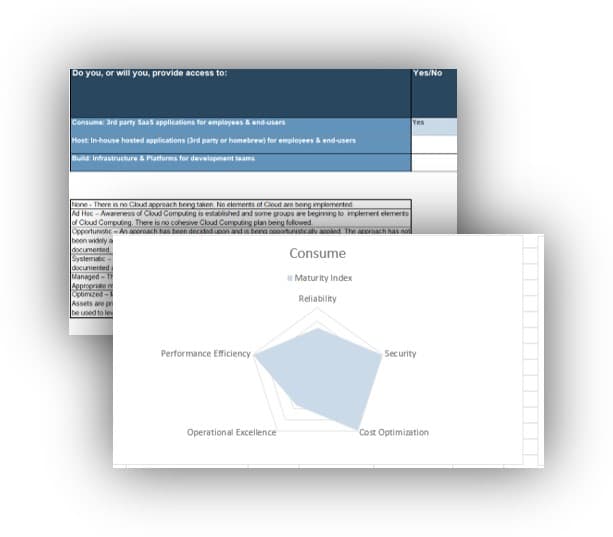 | Identify stakeholders, what’s in it for them, what the impact will be, and how you will communicate over the course of the change. | 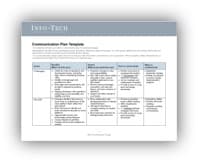 |
Cloud Operations Design Sketchbook Capture the diagram as you build it. | 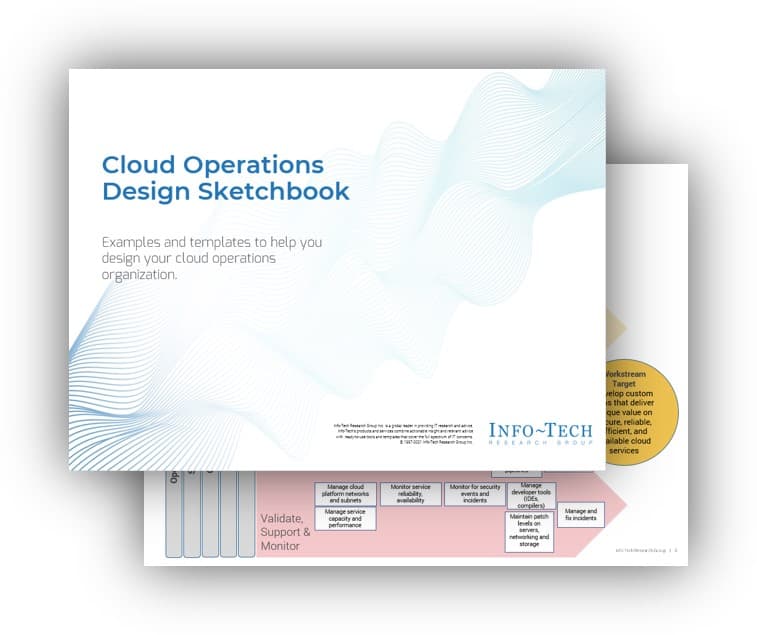 | Build a roadmap to put the design into action. | 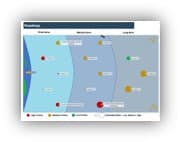 |
Key deliverable:
Cloud Operations Organizing Framework
The Cloud Operations Organizing Framework is a communication tool that introduces the cloud operations diagram and establishes its context and justification.
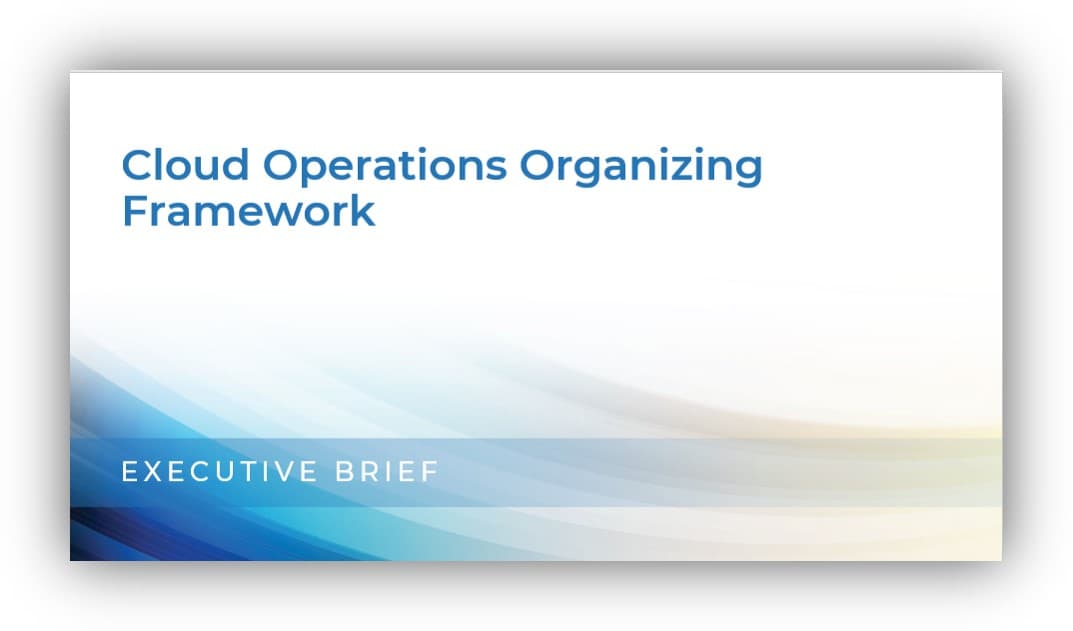
Project Outline
Phase 1: Establish Context 1.1: Identify challenges, opportunities, and cloud maturity 1.2: Evaluate new ways of working 1.3: Define cloud work | Phase 2: Design the organization and communicate changes 2.1: Design a draft cloud operations diagram 2.2: Communicate changes |
Outputs | |
Cloud Services Objectives and Obstacles Cloud Operations Workflow Diagrams Cloud Maturity Assessment | Draft Cloud Operations Diagram Communication Plan Roadmap Tool Cloud Operations Organizing Framework |
Project benefits
Benefits for IT | Benefits for the business |
|---|---|
|
|
Calculate the value of Info-Tech’s Methodology
The value of the project is the delivery of organizational change that improves the way you manage cloud services
Example Goal | How this blueprint can help | How you might measure success/value |
|---|---|---|
Streamline Responsibilities The operations team is spending too much time fighting applications fires, which is distracting it from needed platform improvements. |
|
|
Improve Cost Visibility The teams responsible for cost management today don’t have the authority, visibility, or time to effectively find wasted spend. The teams responsible for cost management today don’t have the authority, visibility, or time to effectively find wasted spend. |
|
|
1. Average wasted cloud spend across all organizations, from the 2022 Flexera State of the Cloud Report
Understand your cloud vision and strategy before you redesign operations
Guide your operations redesign with an overarching cloud vision and strategy that aligns to and enables the business’s goals.
Cloud Vision | 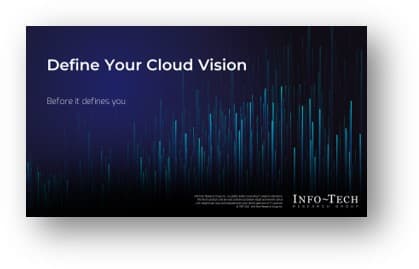 | Cloud Strategy |
|---|---|---|
It is difficult to get or maintain buy-in for changes to operations without everyone on the same page about the basic value proposition cloud offers your organization. Do the workload and risk analysis to create a defensible cloud vision statement that boils down into a single statement: “This is how we want to use the cloud.” | Once you have your basic cloud vision, take the next step by documenting a cloud strategy. Establish your steering committee with stakeholders from IT, business, and leadership to work through the essential decisions around vision and alignment, people, governance, and technology. Your cloud operations design should align to a cloud strategy document that provides guidelines on establishing a cloud council, preparing staff for changing skills, mitigating risks through proper governance, and setting a direction for migration, provisioning, and monitoring decisions. |
Key Insights
Focus on the future, not the present | ||
Define your target cloud operations state first, then plan how to get there. If you begin by trying to reconstruct on-prem operations in the cloud, you will build an operations model that is the worst of both worlds. | ||
Responsibilities change in the cloud | Understand what you mean by cloud work | Focus where it matters |
Cloud is a different way of consuming IT resources and applications and it requires a different operational approach than traditional IT. In most cases, cloud operations involves less direct execution and more service validation and monitoring | Work that is invisible to the customer can still be essential to delivering customer value. A lot of operations work is invisible to your organization’s customers but is required to deliver stability, security, efficiency, and more. Cloud work is not just applications that have been approved by IT. Consider how unsanctioned software purchased by the business will be integrated and managed. | Start by designing operations around the main workflow you have for cloud services. If you mostly build or host in the cloud, build the diagram to maximize value for that workflow. Design principles will often change over time as the organization’s strategy evolves. Identify skills requirements and gaps as early as possible to avoid skills gaps later. Whether you plan to acquire skills via training or cross-training, hiring, contracting, or outsourcing, effectively building skills takes time. |
Info-Tech offers various levels of support to best suit your needs
DIY Toolkit | Guided Implementation | Workshop | Consulting |
|---|---|---|---|
| “Our team has already made this critical project a priority, and we have the time and capability, but some guidance along the way would be helpful.” | “Our team knows that we need to fix a process, but we need assistance to determine where to focus. Some check-ins along the way would help keep us on track.” | “We need to hit the ground running and get this project kicked off immediately. Our team has the ability to take this over once we get a framework and strategy in place.” | “Our team does not have the time or the knowledge to take this project on. We need assistance through the entirety of this project.” |
Diagnostics and consistent frameworks used throughout all four options
Guided Implementation
What does a typical GI on this topic look like?
Phase 1 | Phase 2 |
|---|---|
Call #1: Scope requirements, objectives, and your specific challenges Calls #2&3: Assess cloud maturity and drivers for org. redesign Call #4: Review cloud objectives and obstacles Call #5: Evaluate new ways of working and identify cloud work | Calls #6&7: Create your Cloud Operations diagram Call #8: Create your communication plan and build roadmap |
A Guided Implementation (GI) is a series of calls with an Info-Tech analyst to help implement our best practices in your organization.
Workshop Overview
Contact your account representative for more information.
workshops@infotech.com 1-888-670-8889
Day 1 | Day 2 | Day 3 | Day 4 | Day 5 | |
|---|---|---|---|---|---|
Establish Context | Design the Organization and Communicate Changes | Next Steps and | |||
Activities | 1.1 Assess current cloud maturity and areas in need of improvement 1.2 Identify the drivers for organizational redesign 1.3 Review cloud objectives and obstacles 1.4 Develop organization design principles | 2.1 Evaluate new ways of working 2.2 Develop a workstream target statement 2.3 Identify cloud work | 3.1 Design a future-state cloud operations diagram 3.2 Create a current state cloud operations diagram 3.3 Define success indicators | 4.1 Create a roadmap 4.2 Create a communication plan | 5.1 Complete in-progress deliverables from previous four days. 5.2 Set up review time for workshop deliverables and to discuss next steps. |
Deliverables |
|
|
|
| Cloud Operations Organizing Framework. |
Phase 1:
Establish context
Phase 1 | Phase 2 |
|---|---|
1.1 Establish operating model design principals by identifying goals & challenges, workstreams, and cloud maturity 1.2 Evaluate new ways of working 1.3 Identify cloud work | 2.1 Draft an operating model 2.2 Communicate proposed changes |
Phase Outcomes:
Define current maturity and which workstreams are important to your organization.
Understand new operating approaches and which apply to your workstream balance.
Identify a new target state for IT operations.
Before you get started
Set yourself up for success with these three steps:
- This methodology and the related slides are intended to be executed via intensive, collaborative working sessions using the rest of this slide deck.
- Ensure the working sessions are successful by working through these steps before you start work on defining your cloud operations.
1. Identify an operations design working group | 2. Review cloud vision and strategy | 3. Create a working folder |
|---|---|---|
This should be a group with insight into current cloud challenges, and with the authority to drive change. This group is the main audience for the activities in this blueprint. | Review your established planning work and documentation. | Create a repository to house your notes and any work in progress. |
Create a working folder
15 minutes
Create a central repository to support transparency and collaboration. It’s an obvious step, but one that’s often forgotten.
- Download all the documents associated with this blueprint to a shared repository accessible to all participants. Keep separate folders for templates and work-in-progress.
- Share the link to the repository with all attendees. Include links to the repository in any meeting invites you set up as working sessions for the project.
- Use the repository for all the work you do in the activities listed in this blueprint.
Step 1.1: Identify goals and challenges, workstreams, and cloud maturity
Participants
- Operations Design Working Group, which may include:
- Cloud owners
- Platform/Applications Team leads
- Infra & Ops managers
Outcomes
- Identify your current cloud maturity and areas in need of improvement.
- Define the advantages you expect to realize from cloud services and any obstacles you have to overcome to meet those objectives.
- Identify the reasons why redesigning cloud operations is necessary.
- Develop organization design principles.
“Start small: Begin with a couple services. Then, based on the feedback you receive from Operations and the business, modify your approach and keep increasing your footprint.” – Nenad Begovic
Cloud changes operational activities, tactics, and goals
As you adopt cloud services, the operations core mission remains . . .
- IT operations are expected to deliver stable, efficient, and secure IT services.
. . . but operational activities are evolving.
- Core IT operational processes remain relevant, such as incident or capacity management, but opportunities to automate or outsource operations tasks will change how that work is done.
- As you rely more on automation and outsourcing, the team may see less direct execution in its day-to-day work and more solution design and validation.
- Outsourcing frees the team from operational toil but reduces the direct control over your end-to-end solution and increases your reliance on your vendor.
- Pay-as-you-go pricing models present opportunities for streamlined delivery and cost rationalization but require you to rethink how you do cost and asset management.
- It’s very easy for the business to buy a SaaS solution without consulting IT, which can lead to duplicated functionality, integration challenges, security threats, and more.
Design a model for cloud operations that helps you achieve value from your cloud environment.
“As operating models shift to the cloud, you still need the same people and processes. However, the shift is focused on a higher level of operations. If your people no longer focus on server uptime, then their success metrics will change. When security is no longer protected by the four walls of a datacenter, your threat profile changes.”
(Microsoft, “Understand Cloud Operating Models,” 2022)
Operational responsibilities are shared with a range of stakeholders
When using a vendor-operated public cloud, IT exists in a shared responsibility model with the cloud service provider, one that is further differentiated by the type of cloud service model in use: broadly, software-as a service (SaaS), platform-as-a-service (PaaS), or infrastructure-as-a-service (IaaS).
Your IT operations organization may still reflect a structure where IT retains control over the entire infrastructure stack from facilities to application and defines their operational roles and processes accordingly.
If the organization chooses a co-location facility, they outsource facility responsibility to a third-party provider, but much of the rest of the traditional IT operating model remains the same. The operations model that worked for an entirely premises-based environment is very different from one that is made up of, for instance, a portfolio of SaaS applications, where your control is limited to the top of the infrastructure stack at the application layer.
Once an organization migrates workloads to the cloud, IT gives up an increasing amount of control to the vendor, and its traditional operational roles & responsibilities necessarily change.
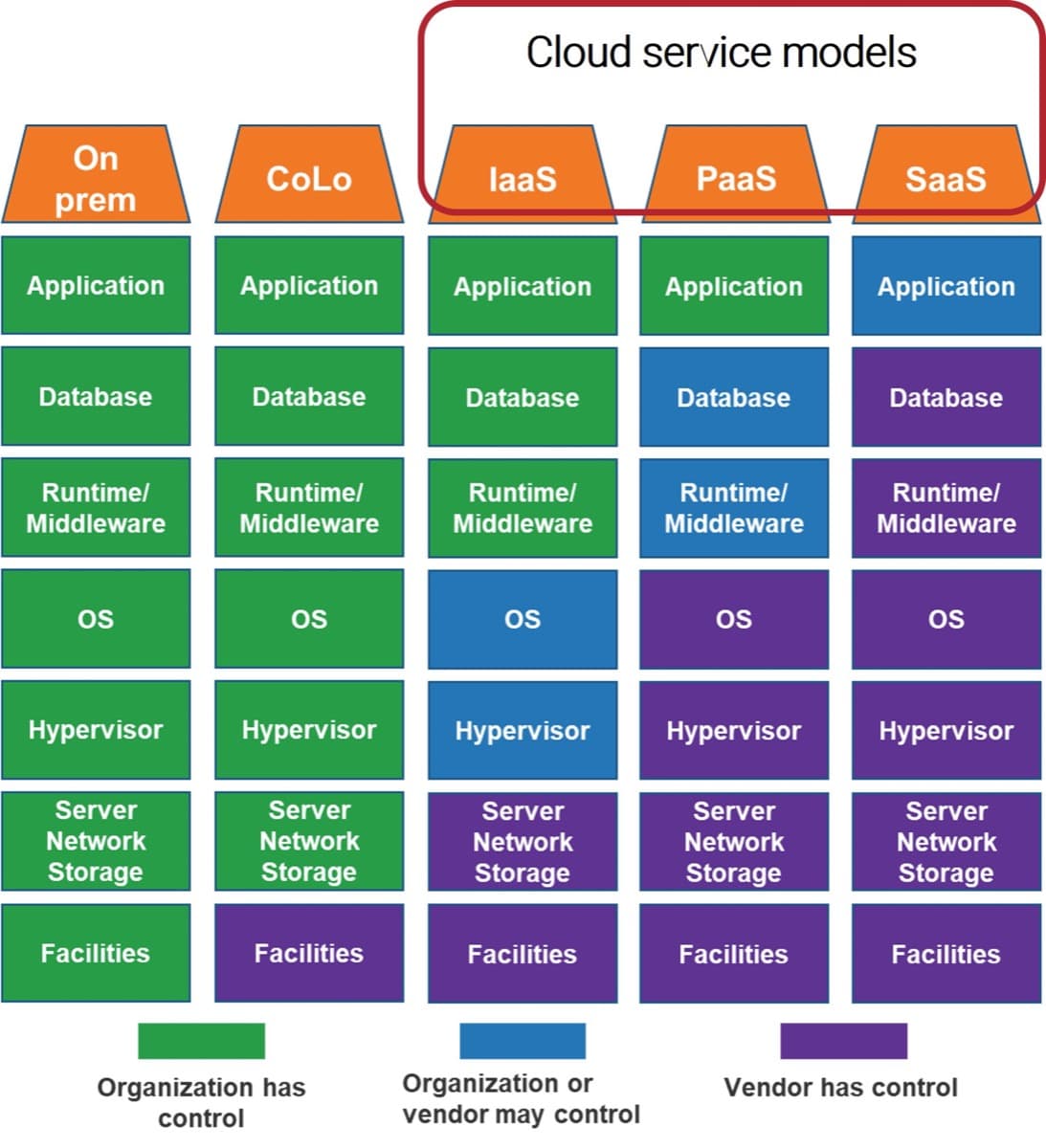
Align operations with customer value
- Decisions about operational design should be made with customer value in mind. Remember that cloud adoption should be an enabler of adaptability in the face of changing business needs!
- Think about how the operations team is indispensable to the value received by your customer. Think about the types of changes that can add to the value your customers receive.
- A focus on value will help you establish and explain the rationale and urgency required to deliver on needed changes. If you can’t explain how the changes you propose will help deliver value, your proposal will come across as change for the sake of change.
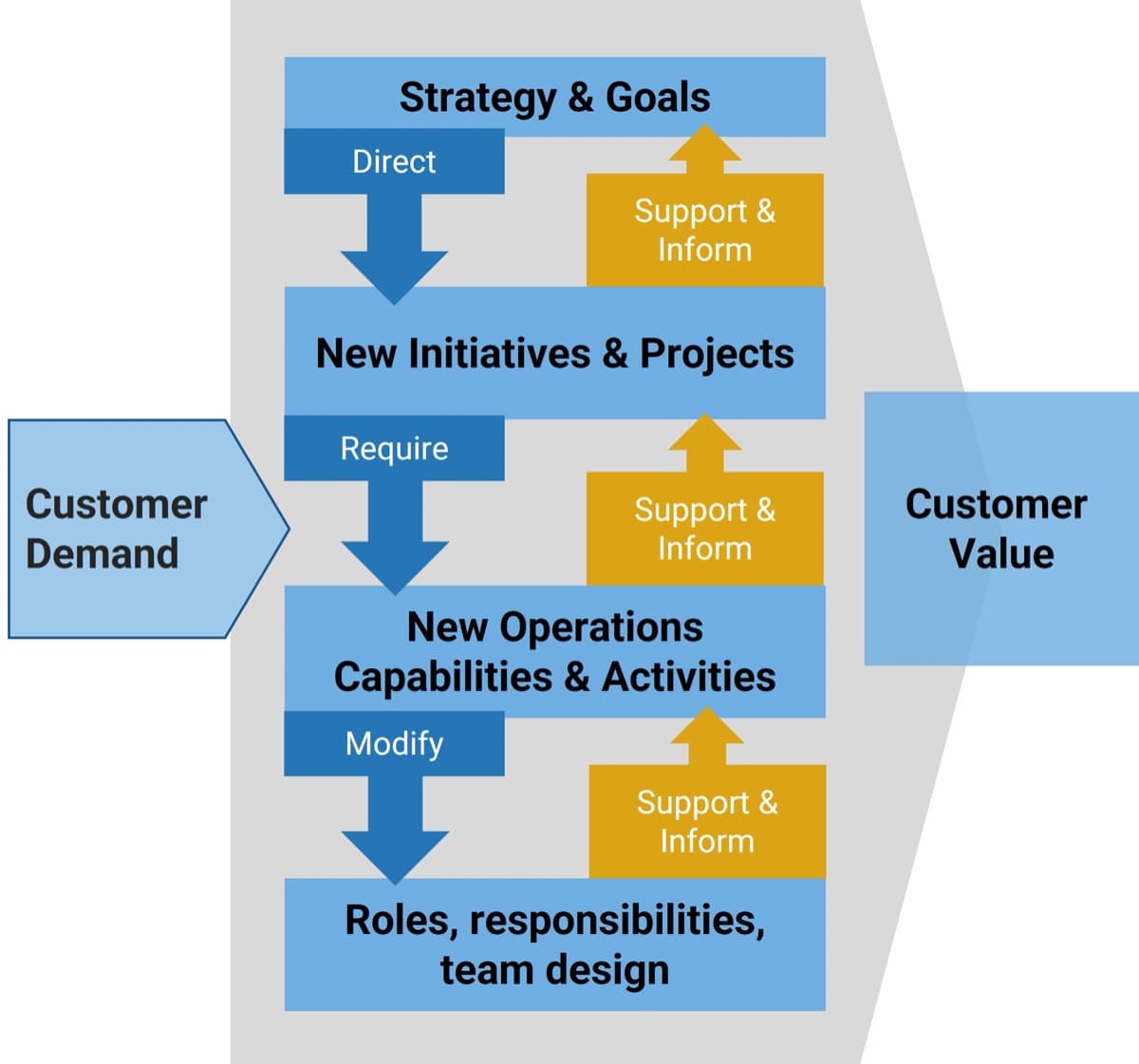
Info-Tech Insight
Work that is invisible to the customer can still be essential to delivering customer value. A lot of operations work is invisible to your organization’s customers but required to deliver stability, security, efficiency, and more.
A new consumption model means a different mix of activities
Evolving to cloud-optimal operations also means re-assessing and adapting your team’s approach to achieving cloud maturity, especially with respect to how automation and standardization can be leveraged to best achieve optimization in cloud.
| Traditional IT | Design | Execute | Validate | Support | Monitor |
| Cloud | Design | Execute | Validate | Support | Monitor |
Info-Tech Insight
Cloud is a different way of consuming IT resources and applications and requires a different operational approach than traditional IT.
In most cases, cloud operations involves less direct execution and more service validation and monitoring.
The Service Models in cloud correspond to the way your organization delivers IT
Service Model | Example | Function |
|---|---|---|
Software-as-a-Service (SaaS) | Salesforce.com Office 365 Workday | Consume |
Platform-as-a-Service (PaaS) | Azure Stack AWS SageMaker WordPress | Build |
Infrastructure-as-a-Service (IaaS) | Microsoft Azure Amazon EC2 Google Cloud Platform | Host |
Define how you plan to use cloud services
Your cloud operations will include different tasks, teams, and workflows, depending on whether you consume cloud services, build them, or host on them.
Function | Business Need | Service Model | Example Tasks |
|---|---|---|---|
Consume | “I need a commodity, off-the-shelf service that we can configure to our organization’s needs. | Software-as-a-Service (SaaS) | Onboard and add users to a new SaaS offering. Vendor management of SaaS providers. Configure/integrate the SaaS offering to meet business needs. |
Build | “I need to create significantly customized or net-new products and services.” | Platform-as-a-Service (PaaS) & Infrastructure as-a-Service (IaaS) | Create custom applications. Build and maintain a container platform. Manage CI/CD pipelines and tools. Share infrastructure and applications patterns. |
Host | “I need compute, storage, and networking components that reflect key cloud characteristics (on-demand self-service, metered usage, etc.).” | Infrastructure-as-a-Service (IaaS) | Stand up compute, networking, and storage resources to host a COTS application. Plan to increase storage capacity to support future demand. |
Align to the well-architected framework
- Each cloud provider has defined a well-architected framework (WAF) that defines effective deployment and operations for their services.
- WAFs embody a set of best practices and design principles to leverage the cloud in a more efficient, secure, and cost-effective manner.
- While each vendor’s WAF has its own definitions and nuances, they collectively share a set of key principles, or “pillars,” that define the desired outcome of any cloud deployment.
- These pillars address the key areas of risk when migrating to a public cloud platform.
“In order to accelerate public cloud adoption, you need to focus on infrastructure-as-code and script everything you can. Unlike traditional operations, CloudOps focuses on creating scripts: a script for task A, a script for task B, etc.”
– Nenad Begovic
Pillars
- Reliability
- Security
- Cost Optimization
- Operational Excellence
- Performance Efficiency
General Best Practice Capability Areas
- Host
- Network
- Data
- Identity Management
- Cost/Subscription Management
Assess cloud maturity
2 hours
- Download a copy of the Cloud Maturity Assessment Tool.
- As a group, work through:
- The balance of your operations activities from a Host/Build/Consume perspective. What are you responsible for delivering now? How do you expect things will change in the future?
- Which workstreams to focus on. Are there activity categories that are critical or non-critical or that don’t represent a significant portion of overall work? Conversely, are there workstreams that you feel are subject to particular risk when moving to cloud?
- Fill out the Maturity Quiz tab in the Cloud Maturity Assessment Tool for the workstreams you have chosen to focus on.
| Input | Output |
|---|---|
|
|
| Materials | Participants |
|
|
Download theCloud Maturity Assessment Tool
Identify the drivers for organizational redesign
Whiteboard Activity
An absolute must-have in any successful redesign is a shared understanding and commitment to changing the status quo.
Without a clear and urgent call to action, the design changes will be seen as change for the sake of change and therefore entirely safe to ignore.
Take up the following questions as a group:
- What kind of organizational change is needed?
- Why do we think the need for this change is urgent?
- What do we think will happen if no change occurs? What’s the worst-case scenario?
Record your answers so you can reference and use them in the communication materials you’ll create in Phase 2.
| Input | Output |
|
|
| Materials | Participants |
|
|
“We know, for example, that 70 percent of change programs fail to achieve their goals, largely due to employee resistance and lack of management support. We also know that when people are truly invested in change it is 30 percent more likely to stick.”
– Ewenstein, Smith, Sologar
McKinsey (2015)
Consider the value of change from advantage and obstacle perspectives
Consider what you intend to achieve and the obstacles to overcome to help identify the changes required to achieve your desired future state.
Advantage Perspective | Ideas for Change | Obstacle Perspective |
What advantages do cloud services offer us as an organization? For example:
| What obstacles prevent us from realizing value in cloud services? For example:
|
Review risks and challenges
Changes to Support Model
- Have we identified who is on the cloud ops team?
- Do we know where we are procuring skills (internal IT vs. third party) and for how long?
- Do we know where we are in the migration process?
Changes to security & governance
- Have we identified how our attack surface changes in the cloud?
- Do we have guardrails in place to govern self-provisioning users?
- Are we managing cost overage risks?
Replicating old habits
- Have we made concrete plans to leverage cloud capabilities to standardize and automate outputs?
- Are we simply reproducing existing systems in the cloud?
Changes to Skills & Roles
- Is our staff excited to learn new skills and technologies? Are our specialists prepared to acquire generalist skills to support cloud services?
- Do we have training plans created and aligned to our technology roadmap?
- Do we know what head count we need?
Misaligned stakeholders
- Have we identified our key stakeholders and teams? Have we considered what changes will impact them and how?
- Are we meeting regularly and collaborating effectively with our peers, or are we siloed?
Review cloud objectives and obstacles
Whiteboard Activity
1 hour
- With your working group, review why you’re using cloud in the first place. What advantages do you expect to realize by adopting cloud services? If we achieve what we’ve set out to do, what should that look and feel like to us, our organization, and our organization’s customers?
- You should have identified cloud drivers and objectives in your cloud vision and strategy – leverage and validate what you already have!
- Next, identify obstacles that are preventing you from fully realizing the value of cloud services.
- Finally, brainstorm initial ideas for change. What could we start doing that could help us better use cloud in the future? Are there changes to how we need to organize ourselves to collaborate more effectively?
| Input | Output |
|
|
| Materials | Participants |
|
|
Commonly cited advantages and obstacles
Cloud Advantages/Objectives
| Obstacles Need to speed up provisioning of PaaS/IaaS/data resources to development and project teams. No time to develop and improve platform services and standards due to other responsibilities. We constantly run up unexpected cloud costs. Not enough time for continuous learning and development. The business will buy SaaS apps and only let us know after they’ve been purchased, leading to overlapping functionality; gaps in compliance, security, or data protection requirements; integration challenges; cost inefficiencies; and more. Role descriptions haven’t kept up with tech changes. Obvious opportunities to rationalize costs aren’t surfaced (e.g. failing to make use of existing volume licensing agreements). Skills needed to properly operate cloud solutions aren’t identified until breakdowns happen. |
Establish organization design principles
You’ve established a need for organizational change. What will that change look like?
Design principles are concise, direct statements that describe how you will design your organization to achieve key objectives and address key challenges.
This is a critically important step for several reasons:
- A set of clear, concise statements that describe what the design should achieve provides parameters that will help you create and evaluate different design options.
- A focused, facilitated discussion to create those statements will help uncover conflicting assumptions between key stakeholders.
- A comprehensive description of the various ways the organization should change makes it easier to identify misaligned or incompatible objectives.
- A description of what your organization should look like in the future will help you identify where changes will be required .
Examples of design principles:
- We will create a path to review and publish effective application/platform patterns.
- A single governing body should have oversight into all cloud costs.
- Development must happen only on approved cloud platforms.
- Application teams must address operational issues that derive from the applications they’ve created.
- Security practices should be embedded into approved cloud platforms and be automatically applied wherever possible.
- Focus is on improving developer experience on cloud platforms.
Info-Tech Insight
Design principles will often change as the organization’s strategy evolves.
Align design principles to your objectives
Developing design principles starts with your key objectives. What do we absolutely have to get right to deliver value through cloud services?
Once you have your direction set, work through the points in the star model to establish how you will meet your objectives and deliver value. Each point in the star is an important element in your design – taken together, it paints a holistic picture of your future-state organization.
The changes you choose to implement that affect capabilities, structure, processes, rewards, and people should be self-reinforcing. Each point in the star is connected to, and should support, the other points.
“There is no one-size-fits-all organization design that all companies – regardless of their particular strategy needs – should subscribe to.”
– Jay Galbraith, “The Star Model”
Establish design principles
Track your findings in the table on the next slide.
- Review the cloud objectives and challenges from the previous activity. As a group, decide from that list: what are the key objectives you are trying to achieve? What are the things you absolutely must get right to get value from cloud services?
- Work through the following questions as a group:
- What capabilities or technologies do we need to adopt or leverage differently?
- How must our structure change? How will power shift in the new structure?
- Will our new structure require changes to processes or information sharing?
- How must we change how we motivate or reward employees?
- What new skills or knowledge is required? How will we acquire those skills or knowledge?
| Input | Output |
|
|
| Materials | Participants |
|
|
Design principles (example)
What is our key objective? |
|
What capabilities or technologies do we need to adopt or leverage differently? |
|
How must our structure change? How will power shift in the new structure? |
|
Will our new structure require changes to processes or information sharing? |
|
How must we change how we motivate or reward employees? |
|
What new skills or knowledge is required, and how will we acquire it? |
|
Step 1.2: Evaluate new ways of working
Participants
Cloud Operations Design Working Group
Outcomes
Shared understanding of the horizon of work possibilities:
- Ways to work
- Ways to govern and learn
Consider the different approaches on the following slides, how they change operational work, and decide which approaches are the right fit for you.
Evaluate new ways of working
Cut through the hype
| “DevOps is a set of practices, tools, and a cultural philosophy that automates and integrates the processes between software development and IT teams. It emphasizes team empowerment, cross-team communication and collaboration, and technology automation.” – Atlassian, “DevOps” “ITIL 4 brings ITIL up to date by…embracing new ways of working, such as Lean, Agile, and DevOps.” – ITIL Foundation: ITIL 4 Edition “Over time, left to their own devices, the SRE team should end up with very little operational load and almost entirely engage in development tasks, because the service basically runs and repairs itself.” – Ben Treynor Sloss, “Site Reliability Engineering” |
The more things change, the more they stay the same:
|
Leverage patterns to think about new ways of approaching operations work
Patterns are strategies, approaches, and philosophies that can help you imagine new ways of working in your own organization.
- The following slides provide an overview of organizing patterns that are applicable to cloud operations.
- These are strategies that have been applied successfully elsewhere. Review what they can and cannot do and decide whether they are something you can use in your own organizational design.
- Not every pattern will apply to every organization. For example, an organization which typically consumes SaaS applications will likely have very little need for SRE approaches and techniques.
Ways to work
- What work do we do? What skills do we need?
- How do we create and support systems?
Ways to govern and learn
- How do we set and enforce rules?
- How do we create and share knowledge?
Explore Applicable Patterns
Ways to work | Ways to govern and learn |
1. DevOps 2. Site Reliability Engineering 3. Platform Engineering | 4. Cloud Centre of Excellence 5. Cloud Community of Practice |
What is DevOps?
“Look for obstacles constantly and treat them as opportunities to experiment and learn.” – Jez Humble, et al. Lean Enterprise: How High Performance Organizations Innovate at Scale
What it is NOT | What it IS | Why Use It |
|---|---|---|
| An operational philosophy that seeks to:
|
|
1 DevOps, SRE, and Platform Engineering
What is Site Reliability Engineering (SRE)?
“Hope is not a strategy” – Benjamin Treynor Sloss, Site Reliability Engineering: How Google Runs Production Systems
What it is NOT | What it IS | Why Use It |
|---|---|---|
|
|
|
1 SRE vs Platform Engineering
2. Lakhani, Usman. “ISite Reliability Engineering: What Is It? Why Is It Important for Online Businesses?,” 2020.
3. Sloss, “Introduction,” 2017
What4 is Platform Engineering?
“Platform engineers can act as a shield between developers and the infrastructure”
– Carlos Schults, “What is Platform Engineering? The Concept Behind the Term”
What it is NOT | What it IS | Why Use It |
|---|---|---|
|
|
|
1 DevOps, SRE, and Platform Engineering
What is a Cloud Center of Excellence?
You need a strong core to grow a cloud culture.
What it is NOT | What it IS | Why Use It |
|---|---|---|
|
|
|
What is a Cloud Community of Practice?
“We have to stop optimizing for programmers and start optimizing for users”
– Jeff Atwood
What it is NOT | What it IS | Why Use It |
|---|---|---|
|
|
|
Reinforce what we mean by patterns
Patterns are . . . | Ways of Working
|
Patterns are also . . . | Ways to Govern and Learn
|
Review the implications of each pattern for organizational design
Ways of Working | |
|---|---|
DevOps | Development teams take on operational work to support the services they create after they are launched to production. Some DevOps teams may be aligned around a particular function or product rather than a technology – there are individuals with skills on a number of technologies that are part of the same team. |
Site Reliability Engineering (SRE) | In the beginning, you can start to adopt SRE practices within existing teams. As demand grows for SRE skills and services, you may decide to create focused SRE roles or teams. SRE teams may work across applications or be aligned to just infrastructure services or a particular application, or they may focus on tools that help developers manage reliability. SREs may also be embedded long-term with other teams or take on an internal consulting roles with multiple teams.1 |
Platform Engineering | Platform engineering will often, though not always, be the responsibility of a dedicated team. This team must work very closely with, and tuned into the needs of, its internal customers. There is a constant need to find ways to add value that aren’t already part and parcel of the platform – or its external roadmap. This team will take on responsibility for the platform, in terms of feature development, automation, availability and reliability, security, and more. They may also be internal consultants or advisors on the platform to developers. |
1. Gustavo Franco and Matt Brown, “How SRE teams are organized and how to get started.”
Review the implications of each pattern for organizational design
Ways to Govern and Learn | |
|---|---|
Cloud Center of Excellence |
|
Cloud Community of Practice |
|
Evolve your organization to meet the needs of increased adoption
Your operating model should evolve as you increase adoption of cloud services.
| Least Adoption | Greatest Adoption |
Initial Adoption | Early Centralization | Scaling Up | Full Steam Ahead |
|
|
|
|
Adapted from Microsoft, “Get Started: Align your organization,” 2021
Choose new ways of working that make sense for your team
1 hour
Consider if, and how, the approaches to management and governance you’ve just reviewed can offer value to your organization.
- List the organizing/managing ideas listed in the previous slides in the table below.
- Define why it’s for you. What benefits do you expect to realize? What challenges do you expect this will help you overcome? How does this align with your key benefits and drivers for moving to cloud?
- List risks or challenges to adoption. Why will it be hard to do? What could get in the way of adoption? Why might it not be a good fit?
- Identify next steps to adopt proposed practices.
Why it’s for us (drivers) | Risks or challenges to adoption | Next steps to build/adopt it | |
|---|---|---|---|
CCoE | |||
DevOps | |||
| Input | Output |
|
|
| Materials | Participants |
|
|
Step 1.3: Identify cloud work
Participants
- Operations Design Working Group
Outcomes
- Identify core work required to deliver value in key cloud workstreams.
“At first, for many people, the cloud seems vast. But what you actually do is carve out space.”
–DevOps Manager
Identify work
Before you can identify roles and responsibilities, you have to confirm what work you do as an organization and how that work enables you to meet your goals.
- A comprehensive approach that connects the work you do to your organizational goals will help you identify work that’s falling through the cracks.
- Identifying work is an opportunity to look at the tasks you regularly execute and ensure they actually drive value.
- Working through the exercise as a group will help you develop a common language around the work you do.
- To make the evident obvious: you can’t decide who should be responsible for something if you don’t know about it in the first place.
Defining work can be a lot of … work! We recommend you start by identifying work for the workstream you do most – Build, Consume, or Host – to focus your efforts. You can repeat the exercise as needed.
Map work in workstream diagrams
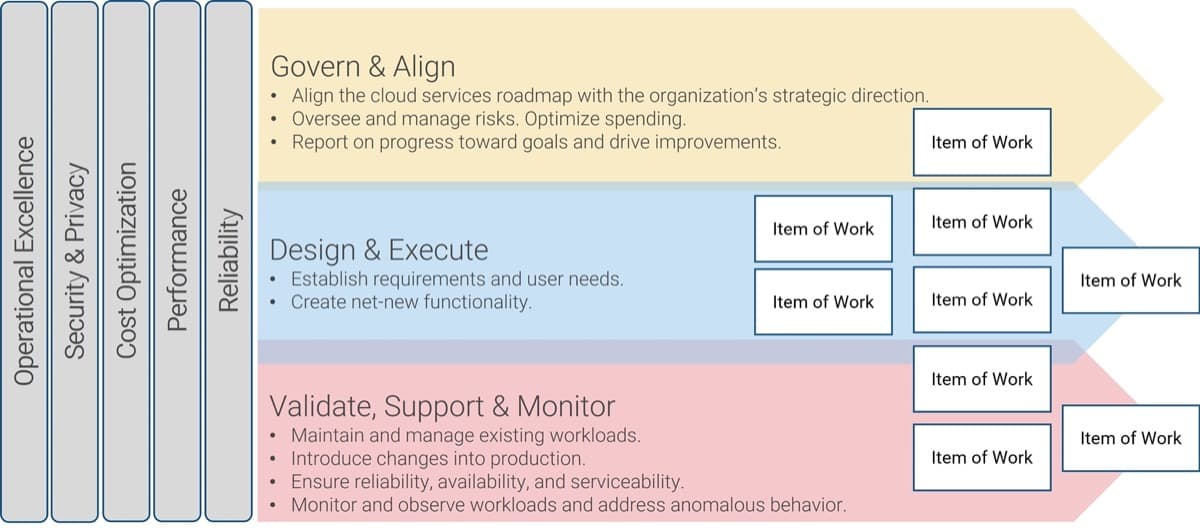
The five Well-Architected Framework pillars. These are principles/directions/guideposts that should inform all cloud work.
The work being done to achieve the workstream target. These are roughly aligned with the three streams on the right.
Workstream Target: A concise statement of the value you aim to achieve through this workstream. All work should help deliver value (directly or indirectly).
Define the scope of the exercise
Whiteboard Activity
20 minutes
Over the next few exercises, you’ll do a deep dive into the work you do in one specific workstream. In this exercise, we’ll decide on a workstream to focus on first.
- Are you primarily building, hosting on, or consuming cloud services? Start with the workstream where you’re doing the most work.
- If this isn’t sufficient to narrow your focus, look at the workstream that is most closely tied to mission critical applications, or that is most in need of review in terms of what work is done and who does it.
- You can narrow the scope further if there’s a very specific sub-area that differs from the rest (e.g. managing your O365 environment vs. managing all SaaS applications).
| Input | Output |
|
|
| Materials | Participants |
|
|
Create a workstream target statement
Whiteboard Activity
30 minutes
In this activity, come up with a short sentence to describe what all this work you do is building toward. The target statement helps align participants on why work is being done and helps focus the activity on work that is most important to achieving the target statement.
Start with this common workstream target statement:
“Deliver valuable, secure, available, reliable, and efficient cloud services.”
Now, review and adjust the target statement by working through the questions below:
- Return to the earlier exercises in Phase 1.1 where you reviewed your key objectives for cloud services. Does the target statement align with what you’d identified previously?
- Who is the customer for the work you do? Would they see the target differently than you’ve described it?
- Can you be more specific? Are there value drivers that are more specific to your industry, organization, business functions, or products that are key to the value your customers receive from this workstream?
| Input | Output |
|
|
| Materials | Participants |
|
|
Identify cloud work
1-2 hours
- Use the workstream diagram template in the Cloud Operations Design Sketchbook, or draw the template out on a whiteboard and use sticky notes to identify work.
- Identify the workstream at the top of the slide. Update the template value statement on the right with the value statement you created in the previous exercise.
- Review one or more of the examples in the Cloud Operations Design Sketchbook to get a sense of the level of detail required for this exercise.
Activity instructions continue on the next slide.
Some notes to the facilitator:
- Working directly from the Cloud Operations Design Sketchbook will save you time with transcription. Sharing the document with participants (e.g. via OneDrive) will allow you to collaborate and edit the document together in real-time.
- Don’t worry about being too tidy for the moment, just get the information written down and you can clean up the diagram later.
| Input | Output |
|
|
| Materials | Participants |
|
|
Identify cloud work (cont’d)
4. Work together to identify work, documenting one work item per box. This should focus on future state, so record work whether it’s actually done today or not. Your space is limited on the sheet, so focus on work that is indispensable to delivering the value statement. Use the lists on the right as a reminder of key IT practice areas.
5. As much as possible, align the work items to the appropriate row (Govern & Align, Design & Execute, or Validate, Support & Monitor). You can overlap boxes between rows if needed.
Have you captured work related to:
ITIL practices, such as:
Security-aligned practices, such as:
Financial practices, such as:
| Data-aligned practices, such as:
Technology-specific tasks, such as:
Other key practices:
|
Info-Tech Insight
Cloud work is not just applications that have been approved by IT. Consider how unsanctioned software purchased by the business will be integrated and managed.
Identify cloud work (cont’d)
6. If you have decided to adopt any of the new ways of working outlined in Step 1.2 (e.g. DevOps, SRE, etc.) review the next slide for examples of the type of work that frequently needs to be done in each of those work models. Add any additional work items as needed.
7. Consolidate boxes and clean up the diagram (e.g. remove duplicate work items, align boxes, clarify language).
8. Do a final review. Is all the work in the diagram truly aligned with the value statement? Is the work identified aligned with the design principles from Step 1.1?
If you used a whiteboard for this exercise, transcribe the output to a copy of the Cloud Operations Design Sketchbook, and repeat the exercise for other key workstreams. You will use this diagram in Phase 2.
Examples of work
Examples of work in the "Host" workstream:
- Bulk patch servers
- Add a server
- Add capacity
- Develop a new server template
- Incident management
Examples of work in the "Build" workstream:
- Provision a production server
- Provision a test environment
- Test recovery procedures
- Add capacity for a service
- Publish a new pattern
- Manage capacity/performance for a service
- Identify wasted spend across services
- Identify performance bottlenecks
- Review and shut down idle/unneeded services
Examples of work in the "Consume" workstream:
- Conduct vendor risk assessments
- Develop a standard evaluation matrix to compare solutions to existing or potential in-house offerings
- Onboard a solution
- Offboard a solution
- Conduct a renewal
- Review and negotiate a contract
- Rationalize software titles
Phase 2:
Design the organization and communicate changes
Phase 1 | Phase 2 |
|---|---|
1.1 Establish operating model design principals by identifying goals & challenges, workstreams, and cloud maturity 1.2 Evaluate new ways of working 1.3 Identify cloud work | 2.1 Draft an operating model 2.2 Communicate proposed changes |
Phase Outcomes:
Draft your cloud operations diagram, identify key messages and impacts to communicate to your stakeholders, and build out the Cloud Operations Organizing Framework communication deck.
Step 2.1: Identify groups and responsibilities
Participants
- Operations Design Working Group
Outcomes
- Cloud Operations Diagram
- Success Indicators
- Roadmap
“No-one ever solved a problem by restructuring.”
– Anonymous
Visualize your cloud operations
Create a visual to help you abstract, analyze, and clarify your vision for the future state of your organization in order to align and instruct stakeholders.
Create a visual, high-level view of your organization to help you answer questions such as:
- “What work do we do? What are the roles and responsibilities of different teams?”
- “How do we interact between work areas?”
- “How has our organization changed already, and what additional changes may be needed?”
- “How do we make technology decisions?”
- “How do we provide services?”
- “How might this change be received by people on the ground?”
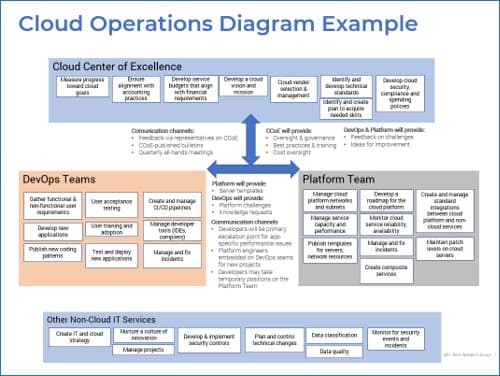
Decide whether to centralize or decentralize
Specialization & Focus: A group or work unit developing a focused concentration of skills, expertise, and activities aligned with an area of focus (such as the ones at right).
Decentralization: Operational teams that report to a decentralized IT or business function, either directly or via a “dotted line” relationship.
Decentralization and Specialization can:
- Duplicate work.
- Localize decision-making authority, which can increase agility and responsiveness.
- Transfer authority and accountability to local and typically smaller teams, clarifying responsibilities and encouraging staff to take ownership for service delivery.
- Enable the team to focus on complex and rapidly changing technologies or processes.
- Create islands of expertise, which can get in the way of collaboration, innovation, and decision making across groups and work units and make oversight difficult.
- Complicate the transfer of resources and knowledge between groups.
Examples: Areas of Focus | Business unit |
| |
Region | |
| |
Service | |
| |
Technology | |
| |
Operational process focus | |
|
“The concept of organization design is simple in theory but highly complex in practice. Like any strategic decision, it involves making multiple trade-offs before choosing what is best suited to a business context.”
– Nitin Razdan & Arvind Pandit
Identify key work areas
Balance specialization with effective collaboration
- Much is said about breaking down organizational silos. But at some level, silos are inevitable – any company with more than one employee will have to divide work up somehow.
- Dividing up work is a delicate balancing act – ensuring individuals and groups are able to do work that is related, meaningful, and that allows autonomy while allowing for effective collaboration between groups that need to work together to achieve business goals.
Why “work areas”?
Why don’t we just use teams, groups, squads, or departments, or some other more common term for groups of people working together?
- We are not yet at the point of deciding who in the organization should be aligned to which areas in the design.
- Describing work areas as teams can shift the conversation to the organizational chart – to who does the work, rather than what needs to be done.
That’s not the goal of this exercise. If the conversation gets stuck on what you do today, it can get in the way of thinking about what you need to do in the future.
Create a future-state cloud operations diagram
1-3 hours
- Review the example cloud operations diagram example in your copy of the Cloud Operations Design Sketchbook.
- Identify key work areas (e.g. applications, infrastructure, platform engineering, DevOps, security). Add the name of each work area in one of the larger boxes.
- Go back to your design principles. Did you define any work areas in your design principles that should be represented here?
- If you have several groups or teams with similar responsibilities, consider lumping them together in one box (e.g. applications teams, 3x DevOps teams).
- Copy the tasks from any workstream diagrams you’ve created to the same slide as the organization design diagram. Keep the workstream diagram intact, as you’ll want to be able to refer back to it later.
Activity instructions continue on the next slide.
| Input | Output |
|
|
| Materials | Participants |
|
|
Cloud operations diagram (cont’d)
1-3 hours
4. As a group, move the work boxes from the workstream diagram into the appropriate work area.
- Don’t worry about being too tidy for the moment – clean up the diagram when the exercise is done.
- Make adjustments to the wording of the work boxes if needed.
5. Use the space between work areas to describe how work areas must interact to achieve organizational goals. For example:
- What information should be shared between groups?
- What information sharing channels may be used?
- What processes will be handed-off between groups and how?
- How often will teams interact?
- Will interactions be formal or informal?
Create a current-state operations diagram
1 -2 hours
This exercise can be done by one person, then reviewed with the working group at a later time.
This current state diagram helps clarify the changes that may need to happen to get to your future state.
- Color code the work boxes for each work area. For example, if you have a “DevOps” work area, make all the work boxes assigned to “DevOps” the same color.
- On a separate slide, sketch your existing organization indicating your current teams.
- Copy the tasks from the future-state diagram to this current-state chart. Align the tasks to the appropriate groups.
- Review the chart with the working group. Discuss: are there teams that are doing work today that will also be done by different teams? Are there groups that may merge into one team? What types of changes may be required?
| Input | Output |
|
|
| Materials | Participants |
|
|
Check for biases to make better choices
Use the strategies below to spot and address flaws in your team’s thinking about your future-state design.
Biases | What’s the risk? | Mitigation strategies |
|---|---|---|
Is the team making mistakes due to self-interest, love of a single idea, or groupthink? | Important information may be ignored or left unspoken. | Rigorously check for the other biases, below. Tactfully seek dissenting opinions. |
Do recommendations use unreasonable analogies to other successes or failures? | Opportunities or challenges in the current situation may not be sufficiently understood. | Ask for other examples, and check whether the analogies are still valid. |
Is the team blinkered by the weight of past decisions? | Doubling-down on bad decisions (sunk costs) or ignoring new opportunities. | Ask yourself what you'd do if you were new to the position or organization. |
Does the data support the recommendations? | Data used to make the case isn't a good fit for the challenge, is based on faulty assumptions, or is incomplete. | If you had a year to make the decision, what data would you want? How much can you get? |
Are there realistic alternative recommendations? | Alternatives don't exist or are "strawman" options. | Ask for additional options. |
Is the recommendation too risk averse or cautious? | Recommendations that may be too risky are ignored, leading to missed opportunities. | Review options to accept, transfer, distribute, or mitigate the risk of the decision. |
Framework above adapted from Kahneman, Lovallo, and Sibony (2011)
Be specific with metrics
Thinking of ways you could measure success can help uncover what success actually means to you.
Work collectively to generate success indicators for each key cloud initiative. Success indicators are metrics, with targets, aligned to goals, and if you are able to measure them accurately, they should help you report your progress toward your objectives.
For example, if your driver is “faster access to resources” you might consider indicators like developer satisfaction, project completion time, average time to provision, etc.
There are several reasons you may not publicize these metrics. They may be difficult to calculate or misconstrued as targets, warping behavior in unexpected ways. But managed properly, they have value in measuring operational success!
Examples: Operations redesign project metrics | |
Key stakeholder satisfaction scores | |
IT staff engagement scores | |
Support Delivery of New Functionality | Double number of accepted releases per cycle |
80% of key cloud initiatives completed on time, on budget, and in scope | |
Improve Operational Effectiveness | <1% of servers have more than two major versions out of date |
No more than one capacity-related incident per Q | |
Define success indicators
Whiteboard Activity
45 minutes
- On a whiteboard, draw a table with key objectives for the design across the top.
- What cloud objectives should the redesign help you achieve? Refer back to the design principles from Phase 1.
- Think about the redesign itself. How will you measure whether the project itself is proceeding according to plan? Consider metrics such as employee engagement scores and satisfaction scores from key stakeholders.
- Consider whether the metrics are feasible to track. Record your decisions in your copy of the Cloud Operations Organizing Framework deck.
| Input | Output |
|
|
| Materials | Participants |
|
|
Populate a roadmap
Tool Activity
45 minutes
- In the Roadmap Tool, populate the data entry tab with the initiatives you will take to support changes toward the new cloud operations organizing framework.
- Input each of the tasks in the data entry tab and provide a description and rationale behind the task (as needed).
- Assign an effort, priority, and cost level to each task (high, medium, low).
- Assign an owner to each task – someone who can take points and shepherd the task to completion.
- Identify the timeline for each task based on the priority, effort, and cost (short, medium, and long term).
- Highlight risk for each task if it will be deferred.
- Track the progress of each task with the status column.
| Input | Output |
|
|
| Materials | Participants |
|
|
Download the Roadmap Tool
Step 2.2: Communicate changes
Participants
- Operations Design Working Group
Outcomes
- Build a communication plan for key stakeholders
- Complete the communication deck Cloud Operations Organizing Framework
- Build a roadmap
“Words, words, words.”
– Shakespeare
Communicate changes
Which stakeholders will be affected by the changes?
Decision makers: Who do you ultimately need to convince to proceed with any changes you’ve outlined?
Peers: How will managers of other areas be affected by the changes you’re proposing? If you are you suggesting changes to the way that they, or their teams, do their work, you will have to present a compelling case that there’s value in it for them.
Staff: Are you dictating changes or looking for feedback on the path forward?
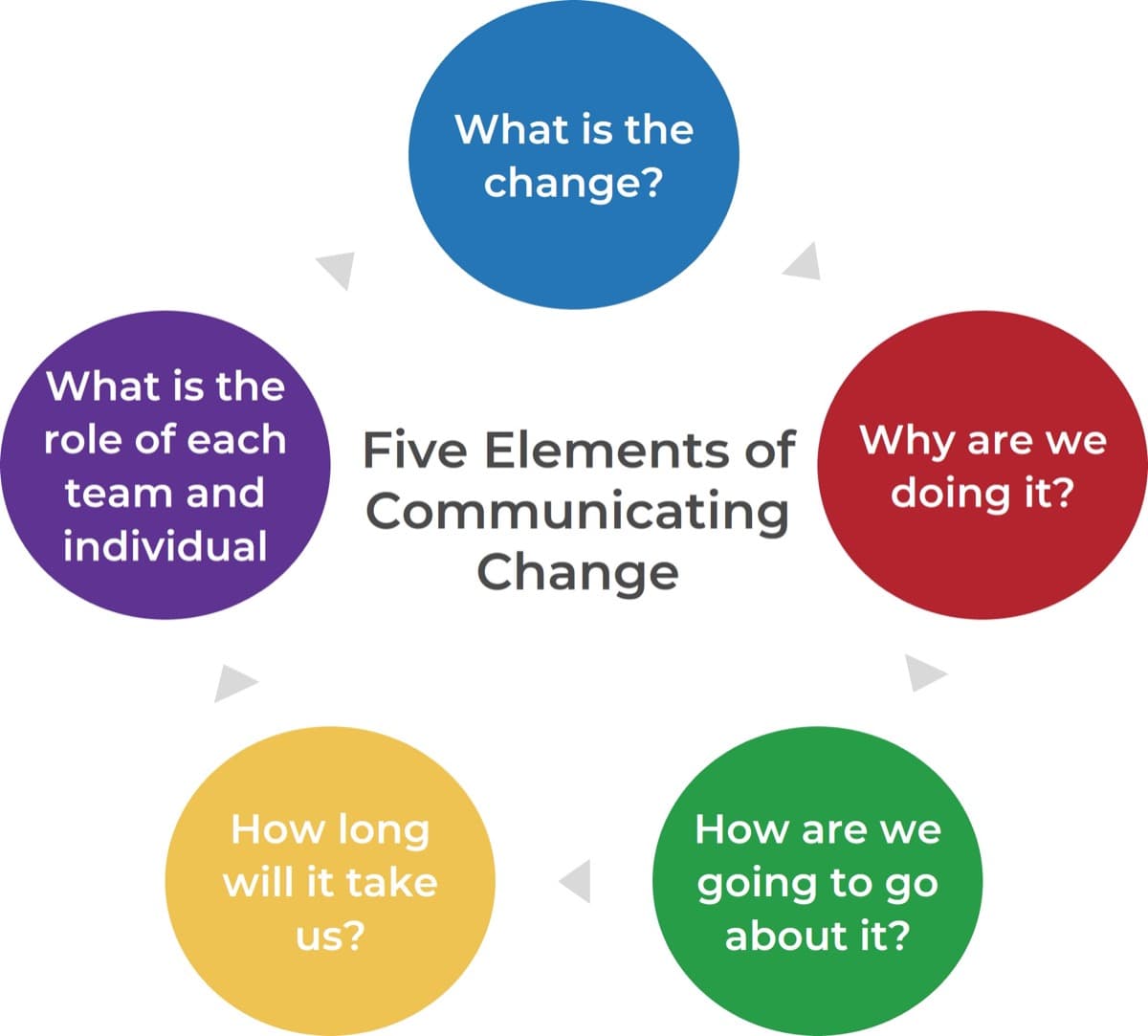
Source: The Qualities of Leadership: Leading Change
Follow these guidelines for good communication
Be relevant
| Be clear
| Be consistent
| Be concise
|
“We tend to use a lot of jargon in our discussions, and that is a sure fire way to turn people away. We realized the message wasn’t getting out because the audience wasn’t speaking the same language. You have to take it down to the next level and help them understand where the needs are.”
– Jeremy Clement, Director of Finance, College of Charleston
Create a communication plan
1 hour
Fill out the table below.
Stakeholder group: Identify key stakeholders who may be impacted by changes to the operations team. This might include IT leadership, management, and staff.
Benefits: What’s in it for them?
Impact: What are we asking in return?
How: What mechanisms or channels will you use to communicate?
When: When (and how often) will you get the message out?
Benefits | Impact | How | When | |
|---|---|---|---|---|
IT Mgrs. |
|
|
|
|
Ops Staff |
|
|
|
|
| Input | Output |
|
|
| Materials | Participants |
|
|
Download the Communication Plan Template
Support the transition with a plan to acquire skills
Identify the preferred way to acquire needed skill sets: contracting, outsourcing, training, or hiring.
- Some cloud projects will change the demand for some skills in the organization, and not all skills should be cultivated internally. Uncertainty about future skills and jobs will cause anxiety for your team and can lead to employee exit.
- Use Info-Tech’s research to conduct a demand analysis to identify which new and critical skills should be acquired via training or hiring (rather than outsourcing or contracting).
- Create a roadmap to clarify when training needs to be completed, a budget plan that accounts for training costs, and role descriptions that paint a picture of future work.
- Within the confines of a collective agreement, managers may be required to retrain staff into new roles before those staff are required to do work in their new jobs. Failing to plan can be more consequential.
- Remember that in cloud, a wealth of automation opportunities present a great option for offloading tasks as well!

Info-Tech Insight
Identify skills requirements and gaps as early as possible to avoid skills gaps later. Whether you plan to acquire skills via training or cross-training, hiring, contracting, or outsourcing, effectively building skills takes time. Use Info-Tech’s methodology to address skills gaps in a prioritized and rational way.
Involve HR for implementation
Your HR team should help you work through:
- Which staff and managers will move to which roles, and any headcount changes.
- Job descriptions, performance metrics, career paths, compensation, and succession planning.
- Organizational change management and implementation plans.
When do you need to involve HR?
Role changes will result in job description changes. |
|
|---|---|
You anticipate changes to the reporting structure. |
|
You anticipate redundancies. |
|
You anticipate new positions. |
|
Training and development budget is required. |
|
Related Info-Tech Research
Define your cloud vision before it defines you. |
Drive consensus by outlining how your organization will use the cloud. |
Map Technical Skills for a Changing Infrastructure & Operations Organization Be practical and proactive – identify needed technical skills for your future-state environment and the most efficient way to acquire them. |
Bibliography
“2021 GitLab DevSecOps Survey.” Gitlab, 2021.
“2022 State of the Cloud Report.” Flexera, 2022.
“DevOps.” Atlassian, ND. Web. 21 July 2022.
Atwood, Jeff. “The 2030 Self-Driving Car Bet.” Coding Horror, 4 Mar 2022. Web. 5 Aug 2022.
Campbell, Andrew. “What is an operating model?” Operational Excellence Society, 12 May 2016. Web. 13 July 2022.
“DevOps.” Atlassian, ND. Web. 21 July 2022.
Ewenstein, Boris, Wesley Smith, Ashvin Sologar. “Changing change management” McKinsey, 1 July 2015. Web. 8 April 2022.
Franco, Gustavo and Matt Brown. “How SRE teams are organized, and how to get started.” Google Cloud Blog, 26 June 2019. Web. July 13 2022.
“Get started: Build a cloud operations team.” Microsoft, 10 May 2021.
ITIL Foundation: ITIL 4 Edition. Axelos, 2019.
Humble, Jez, Joanne Molesky, and Barry O’Reilly. Lean Enterprise: How High Performance Organizations Innovate at Scale. O’Reilly Media, 2015.
Franco, Gustavo and Matt Brown. “How SRE teams are organized and how to get started.” 26 June 2019. Web. 21 July 2022.
Galbraith, Jay. “The Star Model”. ND. Web. 21 July 2022.
Kahnemanm Daniel, Dan Lovallo, and Olivier Sibony. “Before you make that big decision.” Harv Bus Rev. 2011 Jun; 89(6): 50-60, 137. PMID: 21714386.
Kesler, Greg. “Star Model of Organizational Design.” YouTube, 1 Oct 2018. Web Video. 21 Jul 2022.
Lakhani, Usman. “Site Reliability Engineering: What Is It? Why Is It Important for Online Businesses?” Info-Tech. Web. 25 May 2020.
Mansour, Sherif. “Product Management: The role and best practices for beginners.” Atlassian Agile Coach, n.d.
Murphy, Annie, Jamie Kirwin, Khalid Abdul Razak. “Operating Models: Delivering on strategy and optimizing processes.” EY, 2016.
Shults, Carlos. “What is Platform Engineering? The Concept Behind the Term.” liatrio, 3 Aug 2021. Web. 5 Aug 2022.
Sloss, Benjamin Treynor. Site Reliability Engineering – Part I: Introduction. O’Reilly Media, 2017.
“SRE vs. Platform Engineering.” Ambassador Labs, 8 Feb 2021.
“The Qualities of Leadership: Leading Change.” Cornelius & Associates, n.d. Web.
“Understand cloud operating models.” Microsoft, 02 Sept. 2022.
Velichko, Ivan. “DevOps, SRE, and Platform Engineering.” 15 Mar 2022.
Research Contributors and Experts
Nenad Begovic Executive Director, Head of IT Operations MUFG Investor Services |
Desmond Durham Manager, ICT Planning & Infrastructure Trinidad & Tobago Unit Trust Corporation |
Virginia Roberts Director, Enterprise IT Denver Water |
Denis Sharp IT/LEAN Consultant |
Three anonymous contributors |
Buying Options
Design Your Cloud Operations
Client rating
Cost Savings
Days Saved
IT Risk Management · IT Leadership & Strategy implementation · Operational Management · Service Delivery · Organizational Management · Process Improvements · ITIL, CORM, Agile · Cost Control · Business Process Analysis · Technology Development · Project Implementation · International Coordination · In & Outsourcing · Customer Care · Multilingual: Dutch, English, French, German, Japanese · Entrepreneur
Tymans Group is a brand by Gert Taeymans BV
Gert Taeymans bv
Europe: Koning Albertstraat 136, 2070 Burcht, Belgium — VAT No: BE0685.974.694 — phone: +32 (0) 468.142.754
USA: 4023 KENNETT PIKE, SUITE 751, GREENVILLE, DE 19807 — Phone: 1-917-473-8669
Copyright 2017-2022 Gert Taeymans BV
